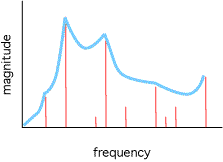

The Formant FilterFormants are resonances, which may be thought of as fixed filters through which a variable excitation is passed. For example, the excitation of a flute is the breathy airstream. The body of the flute filters the airstream into a tonal harmonic sound that defines the formants. A formant filter in a synthesizer attempts to mimic this kind of filtering.The formant filter is built from the detected partials of the sound. For instance, the figure shows a number of partials in red, each at a different frequency and with its own magnitude. The formant filter interpolates between the peaks of the partials at a rate specified by the value of the 'frequency resolution' dial (number 6): low numbers cause the filter to hug the red lines closely while larger numbers cause the blue line to more properly outline the envelope of the spectrum. 
The behavior of the formant filter in the TransFormSynth is controlled by the middle row of dials. 
The 'depth' dial (number 5) balances the sound between all filtered (=1) and no filtering (=0). The 'time resolution' dial (number 7) adds a temporal aspect to the formant filter, giving the filter memory in proportion to its value: "0" represents no memory while a "1" never forgets (for implementation, the value is constrained to a maximum of 0.99). The 'frequency offset' dial (number 8) shifts the blue curve left or right by an amount specified in Hz so that the sound inherits the formant structure of a different frequency range. |
©2008 William Sethares; site design by Anthony Prechtl |